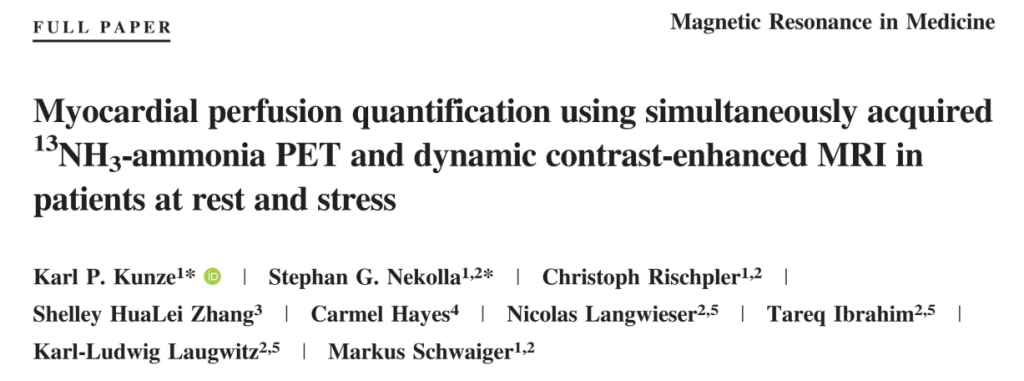

By Giulia Ginami
Karl Kunze was recently awarded his PhD from the Technical University of Munich (TUM), and is now working as a cardiac MRI research scientist for Siemens at King’s College London. Part of Karl’s research, performed during his time at TUM, is summarized in “Myocardial perfusion quantification using simultaneously acquired 13NH3-ammonia PET and dynamic contrast-enhanced MRI in patients at rest and stress”, which is our latest Editor’s Pick article. We met Karl, together with co-author Prof. Stephan Nekolla and senior author Prof. Markus Schwaiger, to talk about their research.
MRMH: Could you tell us about your backgrounds, and how you all ended up working in MRI and in simultaneous PET-MR?
Karl: I studied physics at TUM, and during my master’s degree studies, Prof. Axel Haase supervised me in a project undertaken in collaboration with the Nuclear Medicine Department. The rest is history, as they say! I liked the project, and stayed with Prof. Nekolla and Prof. Schwaiger for my PhD.
Stephan: I was trained by Prof. Haase, too. I am a physicist and I have been working with Markus for almost 25 years on cardiac PET-MR and PET-CT.
Markus: I have trained in cardiology, and this is what drew me to nuclear medicine, which allows non-invasive imaging of cardiac function.
MRMH: Could you tell us a little about how this paper came about? What is the rationale for the study?
Stephan: The interesting thing is that we have been correlating perfusion data from MRI and PET for over 20 years! Back in those days, PET and MRI acquisitions were performed sequentially, whereas today we can acquire data from both modalities simultaneously. This evolution is actually quite a fascinating story!
Markus: Initially, perfusion imaging was performed only using nuclear technologies, but with the advent of MRI it became clear that we had two modalities at our disposal for quantitatively assessing myocardial blood flow. For us, the logical consequence of this realization was to compare them. Subsequently, simultaneous PET-MR became available. In my opinion, the uniqueness of this platform is that it allows us to compare two distinct technologies in the same patient and under the same physiologic condition.
Karl: I actually came on board after the study was conceived. I would say Stephan and Markus have summarized its rationale perfectly.
MRMH: Your study showed differences in rest and stress perfusion ratios between MRI and PET. How can this be explained?
Karl: Our findings echo those of previous studies that compared MRI and PET, albeit not acquired simultaneously. Typically, resting perfusion is reported to be overestimated when using MRI as opposed to PET. One potential reason for this is the particular biodistribution of the contrast agent in MRI, which results in a hematocrit dependency of the final flow that we quantify. In other words, what we are observing is plasma flow, and correction factors are needed in order to make it comparable to blood flow. In this study, we aimed to obtain a better understanding of such systematic differences between the two modalities, which is very important when it comes to defining inter-patient cut-offs and thresholds for diagnosing certain disease patterns.

Stephan: This concept is not new to the nuclear medicine community. For instance, reference values can change between PET and SPECT, where we use different radiotracers.
Markus: First of all, we were happy that all the measurements correlated. This study was challenging to perform as we were trying to measure myocardial blood flow with both MRI and PET simultaneously: Physiology affects the derived measurements in different ways. However, the aim of this study was not to establish the specific thresholds that might allow us to obtain a diagnosis of CAD. Rather, we wanted to show systematic trends and compare different methods of analyzing dynamic MRI results in comparison to PET reference values.
MRMH: Could you comment on the advantages of simultaneous MRI and PET acquisition for the assessment of perfusion in these patients?
Markus: Our intention was to rigorously validate the two modalities in terms of perfusion quantification, and to prove that you can obtain reliable measurements from both. Having established this, it would be sufficient to use one or the other independently. However, PET-MR as a modality goes beyond blood flow measurements, as it allows us to use many different PET tracers and MRI sequences to investigate other tissue characteristics or functions. In short, the possibility of combining many parameters coming from both MRI and PET opens many possibilities for research.
Karl: I completely agree; MRI perfusion imaging offers a lot of other parameters to look at, such as permeability or vascular volume. This is very interesting from a research perspectiveand may allow even more extensive cross-use of information than we have seen to date. If one modality is unable to provide certain data, perhaps the other can help.
MRMH: What would you like to do next?
Markus: Ultimately, we would like to be able to replace invasive coronary angiography with multimodal imaging. The problem with PET-MR right now is that it does not visualize the coronaries as well as CT does. If we could include coronary MR angiography into this approach, and ideally coronary plaque imaging with specific tracers, a comprehensive characterization of CAD will be possible. Perfusion data integrated with information on regional coronary anatomy as well as with molecular signals suggesting the presence of unstable plaques are theoretically available with PET-MR. In the long term, this combination represents every cardiologist’s dream!
Stephan: Twenty years ago, when we started doing PET perfusion, there was a real sense, in part of the community, that this was already something “you could actually do”. But the fact is that, in terms of spatial coverage, what we generate now is the same as what was available back then, and we should really work to improve on this. At the same time, in seeking to develop the technology, we should also remember what it is that PET can uniquely depict, for instance inflammation.
Karl: Building on what Markus and Stephan have said, one of the things I hope this paper conveys is that it’s probably not a wise idea just to replicate other modalities; instead, we need to appreciate the differences between them and develop new standalone paradigms for new imaging modalities such as PET-MR.




